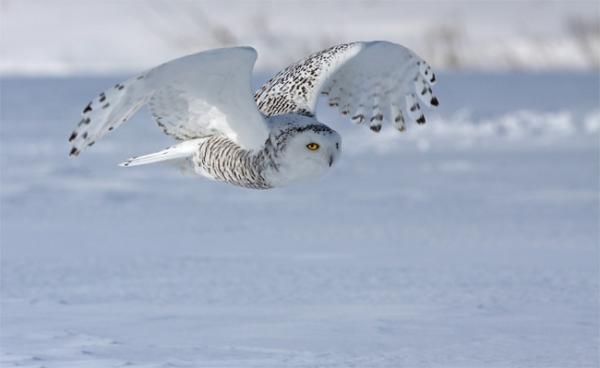Snowy-Owl Migration to US One of Biggest on Record

Snowy owls — large, fluffy, white birds typically found in the Arctic and rarely seen south of the Great Lakes — have swooped down upon the eastern United States in greater numbers than at any time in at least 50 years, one bird expert says. The owls have been spotted as far south as Bermuda, the Carolinas and Missouri, according to news reports.
This migration of snowy owls southward is called an irruption, and this is the "largest of its kind in recent memory," said Kevin McGowan, a bird expert at the Cornell Laboratory of Ornithology at Cornell University.
Snowy owls — the same species as Hedwig, Harry Potter's fictional letter-carrying bird — are magnificent to behold, standing 3 feet (1 meter) tall and sporting a 5-foot (1.5 m) wingspan. "Snowy owls are an Arctic bird adapted to live at the top of the world, and they usually spend the winter up there," as well as the summer, McGowan told LiveScience's OurAmazingPlanet. [Whooo's in There? Amazing Images of Owls]
Mysterious migration
But why are these birds showing up in such large numbers in the Midwest and eastern United States? Typically, such winter migrations take place when the owls' food — mainly rodents, such as lemming — are unavailable. Although nobody knows yet why there are so many snowy owls showing up this year, it could be due to a crash in these lemming populations, or because the rodents are more difficult to hunt when there is more snow on the ground, McGowan said. In addition, more snowy owls may have been born this year compared to in other years, leading to more competition for finite food resources, he said. But scientists likely won't know for a while what factor or factors are behind the large irruption this year.
As for why they're going to the places they've been seen, scientists note that snowy owls are attracted to large, open plains like those found in the Arctic. "They were hatched 1,000 miles from any tree," McGowan said. For this reason, they often end up in coastal plains or at airports, where they can cause problems. This month alone, five airplanes have struck or been hit by snowy owls in the New York City region, according to the Port Authority of New York and New Jersey.
After one of these snowy owls got sucked into a jet engine at JFK International Airport, the species was added to a list of birds that are allowed to be shot and killed, to protect planes from deadly collisions, according to news reports. At least two snowy owls were shot and killed at JFK on Dec. 7. However, after a surge of media attention, the Port Authority said on Dec. 9 that it was reversing its decision to shoot the birds, and that it would try to trap and relocate them.
Sign up for the Live Science daily newsletter now
Get the world’s most fascinating discoveries delivered straight to your inbox.
Spot a snowy owl
The owls are pretty easy to trap, with a lure featuring a live mouse wherein the birds' talons become snared in thin strings, McGowan said. The birds are often quite difficult to scare away using traditional methods, such as shell crackers (which are similar to bottle rockets), he added.
For bird lovers, now is the perfect opportunity to spot snowy owls, McGowan said — he has seen 10 in the past week alone in upstate New York. Curious bird watchers can see if there have been any sightings near them using eBird.org, a tool developed at the Cornell Lab of Ornithology. People can also report their own sightings on the site, he said.
"These are cool birds, and this is the time to see them," McGowan said. They should stick around through the end of February, he added.
Email Douglas Main or follow him on Twitter or Google+. Follow OurAmazingPlanet @OAPlanet, Facebook and Google+. Original article at LiveScience's OurAmazingPlanet.










